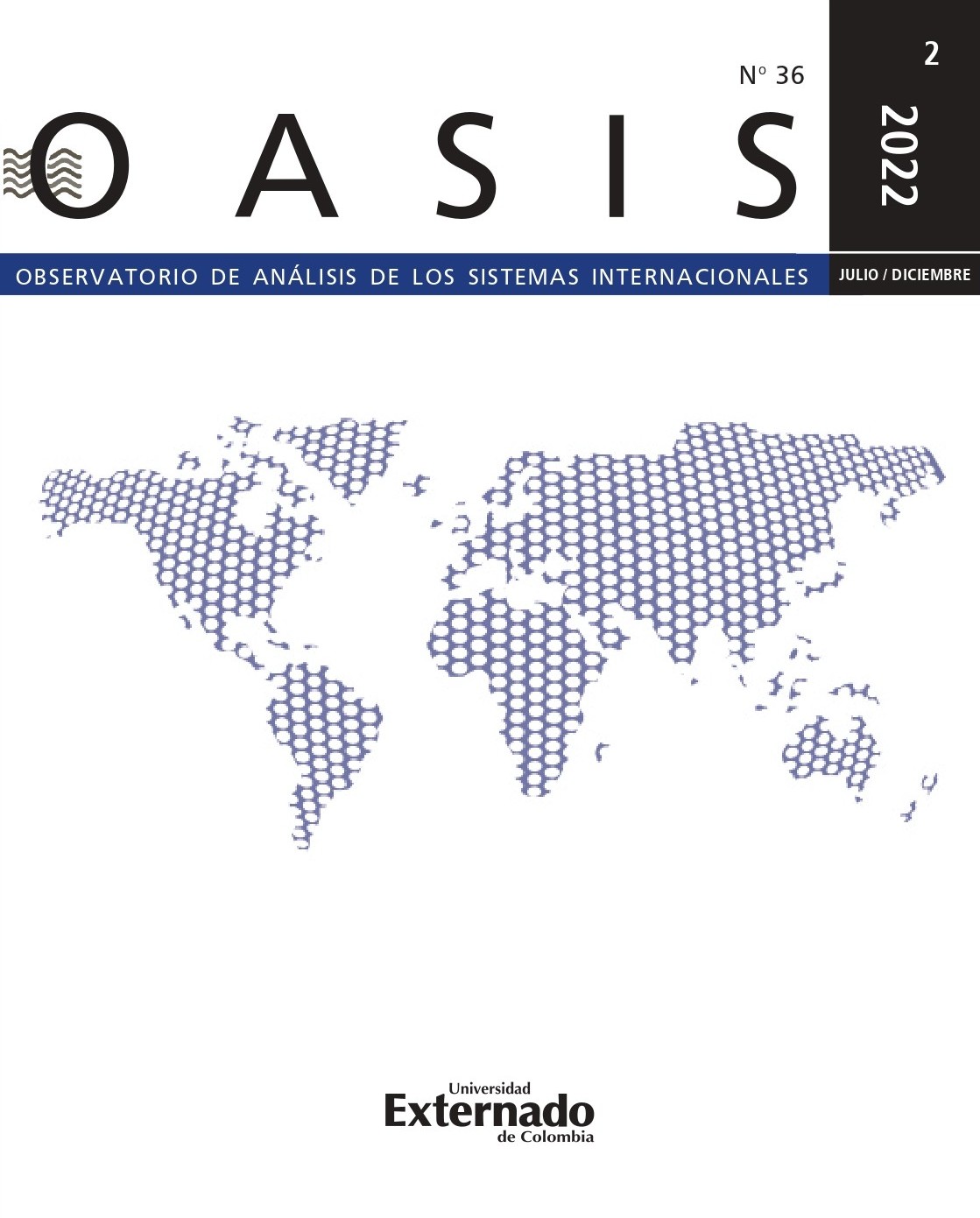Security approaches in East Asia: Analyzing counter positions over power balance
Security approaches in East Asia: Analyzing counter positions over power balance
Contenido principal del artículo
Resumen
Asia Oriental es una región que ha estado dividida por dos esferas de influencia, China y la prooccidental representada por países como Japón, la primera una de las más poderosas en cuanto a sus capacidades políticas, económicas y militares. Lograr el balance de poder en un contexto ideológicamente dividido, en el que abundan los conflictos territoriales y hay intereses que se oponen, ha sido una tarea complicada para los Estados. Ha sido ampliamente discutido que el surgimiento de China como un actor hegemónico con capacidades militares robustas, incluida la nuclear, es materia de preocupación para algunos países de la región, entre ellos Japón, y para la configuración de la agenda política asiática de actores occidentales como Estados Unidos. El propósito de este artículo es analizar los dos enfoques centrales de seguridad en Asia Oriental y cuáles son las motivaciones y los objetivos de los países para rivalizar en torno al poder.
Palabras clave
Descargas
Detalles del artículo
Referencias / Ver
Aviles, A. (2015). The decisiveness of the battle of midway. [Master thesis presented for the Master of Military Art and Science]. Naval Postgraduate School, California. https://apps.dtic.mil/sti/pdfs/ADA623052.pdf
Blagden, D. (2021). When Does Competition Become Conflict? Technology, Geography, and the Offense– Defense Balance. Journal of Global Security Studies. Oxford University Press. https://academic.oup.com/jogss/article/6/4/ogab007/6238548
Boissoneault, L. (2017). The Surprisingly Important Role China Played in WWI. Simthsonian Magazine. https://www.smithsonianmag.com/history/surprisingly-important-role-china-played-worldwar-i-180964532/
CNBC. (2021). Japan prime minister vows to step up defense amid China and North Korea threats. https://www.cnbc.com/2021/11/27/japan-pm-vows-tostep-up-defense-amid-china-and-north-koreathreats.html
Cordesman, A., & Hwang, G. (2021). Updated Report: Chinese Strategy and Military Forces in 2021. Center for Strategic and International Studies. https://www.csis.org/analysis/updated-report-chinesestrategy-and-military-forces-2021
Dillon, M. (2010). China: A Modern History. New York, Palgrave MacMillan.
Iida, M. (2021). China’s Security Threats and Japan’s Responses. Strategic Japan Papers 2021. https://csis-website-prod.s3.amazonaws.com/s3fs-public/210405_Iida_Security%20Issues.pdf?Ag0IL6LQTTMb_HXsk3XJnIDMLazbE9Bg
Kim, K. (2012). The Sino-Japanese War (1894-1895): Japanese National Integration and Construction of the Korean “Other”. International Journal of Korean History, 7(1). https://ijkh.khistory.org/upload/pdf/17-1-1.pdf
Lobell, S. (2017). Structural Realism/Offensive and Defensive Realism. Oxford Research Encyclopedias, International Studies. https://oxfordre.com/internationalstudies/view/10.1093/acrefore/9780190846626.001.0001/acrefore-9780190846626-e-304
Lozoya, J., & Kerber, V. (2011). Japón Contemporáneo. En M. Tanaka (Coord.), Historia mínima de Japón. El Colegio de México.
Martínez, O. (2011). Presión demográfica y movimientos sociales. En M. Tanaka (Coord.). Historia mínima de Japón. El Colegio de México.
Mijah, E. B. (2007). Democracy, Internal Security and Challenges of Policing in Nigeria. Paper Presented at International Conference, Evengelische AkademieLocum, 15-17 June, 2007. https://www.researchgate.net/publication/348602721_Democracy_and_National_Security_Challenges_in_Nigeria
Ministry of Defense of Japan. (2021). Defense of Japan White Paper 2021. https://www.mod.go.jp/en/publ/w_paper/wp2021/DOJ2021_Digest_EN.pdf
Ministry of Defense of Japan (2013). National Security Strategy. https://www.mod.go.jp/en/d_policy/basis/strategy/index.html
Ministry of Defense of the United States of America (2021). Military and security developments involving the People’s Republic of China 2021. https://www.csis.org/analysis/updated-report-chinesestrategy-and-military-forces-2021
Organski, A.F.K. (1968) World Politics. Second edition. Knopf.
Shangsheng, Ch. (2020). The Chinese Tributary System and Traditional International Order in East Asia during the Ming and Qing Dynasties from the Sixteenth to Nineteenth Century. Journal of Chinese Humanities, 5. https://brill.com/downloadpdf/journals/joch/5/2/article-p171_4.xml
Skřivan Sr., A., & Skřivan Jr., A. (2015). Great Powers and the Sino-Japanese War 1894-1895. Prague Paper on the History of International Relations, 2. https://dspace.cuni.cz/bitstream/handle/20.500.11956/96554/1398376_ales_skrivan_16-44.pdf?sequence=1&isAllowed=y
Snyder, J. (1991). Myths of Empire: Domestic Politics and International Ambition. Cornell University Press. The Japan Times (2021). 2022 will be a critical year for Japan’s security. https://www.japantimes.co.jp/opinion/2021/12/31/editorials/japans-securitysituation/
The State Council Information Office of the People’s Republic of China (2019). China’s National Defense. https://english.www.gov.cn/archive/whitepaper/201907/24/content_WS-5d3941ddc6d08408f502283d.html
Williams, P. (2008). Security Studies: An Introduction. Routledge.
Yukaba, U., & Shuaibu, M. (2016). The concept of security and the emerging theoretical perspectives. Paper presented at the Ahmadu Bello University Conference on the Theme “Corruption, Security and National Development” Held between 28th and 30th September, 2016. https://www.researchgate.net/publication/339676247_THE_CONCEPT_OF_SECURITY_AND_THE_EMERGING_THEORETICAL_PERSPECTIVES










